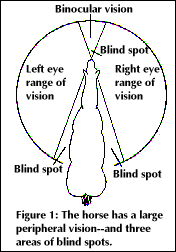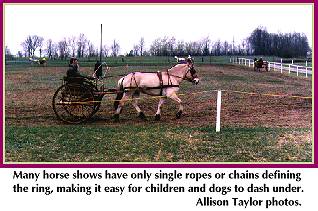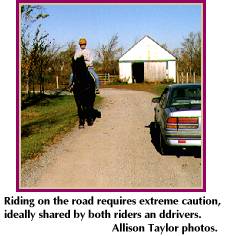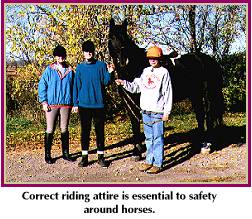|
|
Safety Around Horses
The Equine Research Centre, Guelph, Ontario
A basic guide for beginning horse
people
Getting involved in horses is a wonderful and
rewarding way to learn new skills, develop a relationship with a fascinating
animal, and meet new friends in the process. Like many activities, however,
equestrian sport also involves some degree of risk. Horses are large, powerful
animals, easily capable of injuring a person. But, if you are well armed with a
basic understanding of horses, a few hard and fast rules, and your own good
sense, the risks are readily minimized.
 |
Never touch or feed a horse
without the owner's permission. |
 |
Approach a horse from the front or side, never
from the rear. Announce your presence and offer your hand for the animal to
smell. |
 |
Avoid sudden movements such as waving, running
etc. |
 |
Speak quietly; avoid loud or unusual
noises. |
 |
Keep young children and dogs under direct
control at all times. |
 |
Sturdy footwear and an approved helmet are
essential if you intend to ride. |
|
Understanding
Horses
The biggest risk in being around horses occurs
when they are frightened. At this time, their only concerns are escape and
survival, and people who are in the wrong place at the wrong time can be hurt.
Therefore, the easiest way to prevent such accidents is to understand what
frightens horses. Horses are prey animals; in the wild, they are constantly at
risk of being eaten. As a result, they have evolved systems of behaviour to
help them successfully detect and avoid predators. Specifically, horses are
always on the lookout. Their long necks, widely spaced eyes, and mobile ears
help them be aware of things all around them. This means that they see things
"out of the corner of their eye" much better than humans, whose eyes
are on the front of their faces. Equine ears swivel in all directions, allowing
them to hear and locate faraway sounds. These
abilities are crucial to horses' survival, because despite their speed, they
are not as fast as many of their natural predators. Early detection is
therefore essential. Having widely-spaced eyes means that the horse's field of
peripheral vision is very large (Fig. 1), but it also limits his field of
binocular vision (i.e., where he sees with both eyes at once) to a small area
directly in front of him. Binocular vision is essential to accurately judge
distance and depth. Therefore, most of the things a horse sees are only
one-dimensional - and it is difficult for him to know exactly where they are.
In terms of the horse's survival, it really doesn't matter - all he has to do
is run the other way. But it does mean that horses will often
"overreact" to little things behind and beside them. These
abilities are crucial to horses' survival, because despite their speed, they
are not as fast as many of their natural predators. Early detection is
therefore essential. Having widely-spaced eyes means that the horse's field of
peripheral vision is very large (Fig. 1), but it also limits his field of
binocular vision (i.e., where he sees with both eyes at once) to a small area
directly in front of him. Binocular vision is essential to accurately judge
distance and depth. Therefore, most of the things a horse sees are only
one-dimensional - and it is difficult for him to know exactly where they are.
In terms of the horse's survival, it really doesn't matter - all he has to do
is run the other way. But it does mean that horses will often
"overreact" to little things behind and beside them.
Equine Body
Language
Take some time to observe horses from a
distance, and learn a bit of their body language. When startled, a horse (like
all animals) has three typical reactions. Some will show all three in
succession; others may show only one in a given situation. If you can recognize
these signs, you will be better able to predict and avoid danger. First, a
horse will usually freeze. This makes him less noticeable to the potential
predator, while allowing him to better identify the source. The horse will
usually look intently in the direction of the surprising stimulus, with its
head up and ears perked. The animal is often very tense, and a second startle
may cause it to bolt. Second, horses run. Many will freeze momentarily before
running, but many may not. Prior to running, a horse may sidestep, spin, rear,
or jump, and it is these actions which are particularly likely to injure
onlookers. Finally, if cornered, horses will fight. Despite their size and
power, they are really not ideally suited to warding off predators, lacking
weapons such as horns. They can, however, do considerable damage with their
hooves and teeth. Never corner a panicked horse.
Approaching a
Horse
In terms of your safety, then, you should be
aware that horses are most easily scared by sudden movements or loud noises,
particularly outside of the animal's field of binocular vision. Quick movements
or loud noises in these areas will trigger fear reactions such as spinning or
bolting, and you may get trampled or kicked in the process. For this reason,
avoid approaching horses from the rear or side. Move to the head, giving the
animal a chance to see you. Most horses are more used to being approached from
the left. Announce your presence and put a hand on the horse's neck or shoulder
so he knows where you are. Offer your hand in a closed fist for the horse to
smell. Never run up to a horse, throw things toward a horse, or move in a quick
or unpredictable manner. Never stand directly behind a horse; he cannot see you
well there, and you risk being kicked. By learning about horses, how they
perceive and react to the world, and by adopting a few basic rules of conduct,
you can look forward to safe and enjoyable interaction with these beautiful
creatures. Let's now consider some specific situations where you may come into
close contact with horses: the horse show, while driving your car, and in the
context of your first ride.
At a Horse Show
For many people, a local fair or horse show is
their first close-up exposure to horses. Going to a show is a wonderful way to
learn more about the different types and uses of equines, to meet people
involved in the sports that interest you, and to make contacts that may lead
you to riding lessons, or even your first horse. For the competitors, however,
a horse show is a serious thing. Behind the scenes at a show can get pretty
hectic, and there are risks to both spectators and horses alike. In addition to
the basics we have just covered, here are some specific cautions for the horse
show environment:
- Keep children under direct control at all
times. Young children are often very excited at seeing horses and other
livestock, and many will run up to them, unaware of the risks. By their very
nature, children represent those things horses find most frightening: sudden
movements and loud noises. Teach your children the correct way to approach
animals, always first asking the owner for permission to do so.
- Leave your dog at home. Dogs that are not used
to horses may bark, lunge, or chase. Horses that are not used to dogs may
become panicked by such behaviour. Further, summer shows can get hot, making
parked cars unsafe for dogs and creating problems with access to water and
shade. In addition, having a dog may limit your access to parts of the show
grounds (stands, etc), reducing your enjoyment of the event. For the safety of
both dogs and horses, leave your pet at home.
- Be especially careful at ringside. Many
outdoor shows have only single ropes or chains defining the showring, and
children or dogs could easily dash under these into the ring. Avoid sudden
movements such as taking off jackets or shaking out blankets while there is a
class in progress.
- Occasionally horses break free from their
handlers at shows, and the call "Loose horse!" will ring out. Perhaps
the rider has fallen, or the animal has escaped from its stall. In such
situations, some horses wander harmlessly, but more often they become
frightened by the activity, the strange environment, and people trying to catch
them. Remain calm. Running will only frighten the animal more, and increases
your risk of being hurt. Restrain your children, and move slowly towards a
solid object, such as a building or tree. Stand still and let those with more
experience handle the situation. If the horse runs toward you, stand your
ground, make yourself appear large by holding out your arms, and speak to the
animal in an authoritative tone. In most cases, it will avoid you.
- Avoid taking flash photographs while horses
are competing in the ring. Flashes of light can startle horses, distracting
them from the task at hand and risking injury or collision.
- Never feed a horse anything without the
permission of the owner. Some horses may be on very controlled diets, others
may nip; in any case, it is discourteous and potentially dangerous to feed a
horse at a show, even if only grass. Never tease a horse with food.
- For your own safety and comfort, bring a few
essentials with you. For outdoor events, remember your sunscreen, sunglasses,
hat, and insect repellent. Sturdy footwear will protect you from rough terrain
as well as horses' hooves. If you suffer from allergies to animals or dust, be
sure to bring appropriate relief with you; horse shows are full of both!

Sharing the Road
 Do you know what to do
if, when in your car, you meet a horse being ridden or driven down the road?
This can be a particularly dangerous situation for all concerned: if
frightened, the horse may bolt into the oncoming vehicle or jump into a ditch
or fence line. The horse may be injured, the rider or driver thrown, or your
car damaged. Your best strategy is to slow to a crawl, keeping to the opposite
side of the road. Dim or turn off your headlights, if possible, and turn down
your car stereo. If the horse appears particularly nervous, stop and wait for
the rider to either enter a laneway or wave you by. Never brake or accelerate
suddenly, both of which cause noise and throw up gravel. Spraying gravel will
certainly frighten and may even injure the horse. Never, ever honk the horn.
When you are well past the horse, accelerate gradually and be on your way. Do you know what to do
if, when in your car, you meet a horse being ridden or driven down the road?
This can be a particularly dangerous situation for all concerned: if
frightened, the horse may bolt into the oncoming vehicle or jump into a ditch
or fence line. The horse may be injured, the rider or driver thrown, or your
car damaged. Your best strategy is to slow to a crawl, keeping to the opposite
side of the road. Dim or turn off your headlights, if possible, and turn down
your car stereo. If the horse appears particularly nervous, stop and wait for
the rider to either enter a laneway or wave you by. Never brake or accelerate
suddenly, both of which cause noise and throw up gravel. Spraying gravel will
certainly frighten and may even injure the horse. Never, ever honk the horn.
When you are well past the horse, accelerate gradually and be on your way.
Your First Ride
So, you've decided to take the
plunge and learn to ride. Whether at a riding school, a trail riding
establishment, or a friend's stable, there are a few basic rules you should
follow to ensure a safe and enjoyable first ride.

- Wear a helmet. Helmets have saved untold
numbers of lives in riding accidents - don't even think of riding without one.
If driving is your chosen sport, you should also wear a helmet. Head injuries
can occur if you are thrown out of the cart. Make sure the helmet fits snugly,
and has a solid chin strap to hold it securely in place. Avoid helmets labeled
as "items of apparel", as these have no real protective value. Look
instead for a logo indicating approval by a safety or standards organization,
such as the Canadian Standards Association or equivalent such as (in the U.S.)
the American Society for Testing and Materials (ASTM) or the Safety Equipment
Institute (SEI) Bicycle helmets are used by many pleasure riders, who find them
cooler than conventional equestrian helmets. As long as they are similarly
endorsed by a recognized standards organization, they are a safe alternative.
- Wear solid shoes with heels. Never ride
barefoot, in sandals, or in slip-on shoes such as loafers. Your feet must
support you in the stirrups, and flimsy shoes can fall off or get in the way.
Heels are important to prevent your foot from going all the way through the
stirrup and getting stuck. Sneakers are unacceptable. A lightweight, ankle-high
boot with laces is ideal.
- Wear comfortable but not overly baggy
clothing. Tight jeans do not stretch and are uncomfortable to ride in. Very
loose clothes can chafe, or catch on fences or tree branches. Sweat pants or
exercise tights are a good choice. Men should consider some form of athletic
support for their comfort and safety. Don't chew gum (which can be inhaled) and
avoid carrying anything in your pockets, such as a wallet (which is
uncomfortable) or a pen (which could stab you if you fall).
- Before saddling or harnessing, check all
equipment to ensure that it is in good condition and free from foreign bodies
that may irritate the animal. Do not use equipment that is cracked or frayed,
as it may snap during use.
- Finally, use your own good judgement and be
realistic about your abilities. Do not ride a horse that frightens you. Be
patient with the animal and with yourself. Learning to ride or drive a horse is
a long-term prospect, and you will not be able to gallop across fields, jump
fences, or rope cattle on your first outing. If you enjoy your first
experience, seek out an experienced, qualified instructor and enjoy the process
of learning. It is a wonderful adventure.
|


